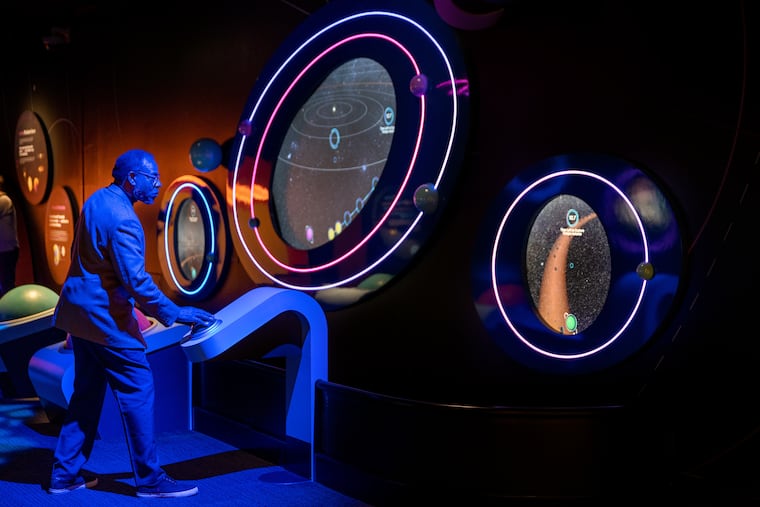Franklin Institute unveils its new $8.5 million exhibit, ‘Wondrous Space,’ and a new logo
The exhibit is the first of six new permanent exhibits coming to the Franklin through 2024.

I’m a huge space nerd. My favorite movie is 2001: A Space Odyssey, I have the opening monologue of Star Trek memorized by heart, and I already have plans to be in the path of totality for the solar eclipse next year.
When I look up at the night sky I feel small, but I also feel a part of something so much greater than myself. The vastness of space, and our limited knowledge of it, gives me hope.
Out there, anything and everything is still possible.
The Franklin Institute taps into that feeling with its new permanent core exhibit, “Wondrous Space,” which opens Saturday. I got a sneak peek during a media preview on Thursday and I’d probably still be there — testing how high I can jump on Jupiter or trying to build a rocket that didn’t explode on takeoff — if I didn’t have to come back down to earth and write this story.
During the event, the Franklin also unveiled a new logo, “TFI,” and a new slogan “There’s more inside,” to signify changes the museum is making as it approaches its 200th anniversary in 2024. “Wondrous Space” is the first of six new permanent “future-focused” exhibits that are set to replace 12 existing ones over the next two years (other topics include the human body and computer science). But not to worry, the beloved Giant Heart and Baldwin locomotive will remain.
“Wondrous Space,” a two-story, $8.5 million exhibit, was funded, in part, by a $3 million grant from Boeing. The exhibit was guided by the Franklin’s chief astronomer, Derrick Pitts, and creative development was led by Orlando-based experiential design firm MDSX and its creative director, Dan Picard (no relation to Capt. Jean-Luc Picard). The Franklin’s chief experience and strategy officer, Abby Bysshe, and her team focused on storytelling, and area students were engaged to provide feedback and advice.
What’s in ‘Wondrous Space’?
The first floor is an immersive world of neon lights, ambient ethereal sounds, and sensory experiences. In one display, which is projected onto the floor, I became the center of gravity for a celestial body, gathering space debris around my feet as I moved. And in a new take on the gravity well — those old coin vortex funnels you used to put pennies in at the mall — the Franklin has created one which tracks the orbits of tiny balls with LED lights as you spin them down the funnel (hint: If you put multiple balls down at once, you can create explosions).
“I’m going to find all my staff here,” said Larry Dubinski, Franklin president and CEO, as he spun balls down the funnel.
Well this is a lot cooler than the ones I put pennies in at the mall as a kid. pic.twitter.com/osTyNchRBb
— Stephanie Farr (@FarFarrAway) November 2, 2023
But my favorite part of the first floor was a large inclined circle which invites visitors to lay down, look up, and hear about the nebulas and galaxies projected overhead. It allowed me to do what I love — be silent, gaze above, and imagine all the possibilities out there.
The second level focuses on space innovation, technologies, and professions in STEM. Picard said he wanted kids who visit the exhibit to imagine all the jobs that play a role in space travel — from the chefs who create food to be taken into space to the horticulturists who will find how to grow food in it (do not sleep on “plant your own space garden”; it blew me away).
In one section, you can view a 10-foot rocket engine from Kennedy Space Center, then turn around and create your own rocket on an interactive display (sadly, I am no rocket scientist; all three of mine crashed).
Other interactives allow you to search for signs of life on other planets and design your own rover and spacesuit. As I was playing at the Rover Design station by AMETEK, Inc., a Berwyn-based tech company, a construction worker approached me.
“Pretty cool, right?” he said. “We had no idea what we were building, but when it was done I couldn’t get enough.”
It’s clear — as Dubinski, Picard, and others stressed during their remarks, that diversity, equity, and inclusion played a large role in the creation of the exhibit. On the second level, videos of STEM professionals from various backgrounds are featured, and at the interactive where visitors can test how high they can jump on other worlds, there’s an option for people who use wheelchairs.
Also opening in conjunction with the exhibit is the limited-time display of Mars, a sculpture of the red planet that’s 23 feet in diameter by UK artist Luke Jerram and created with data from NASA’s Mars Reconnaissance Orbiter. Mars will remain suspended in the atrium until Nov. 19, where it’s accompanied by an original score.
“Wondrous Space” is light-years beyond “Space Command,” the Franklin’s previous space exploration exhibit, which was 20 years old, but I do think it suffers from being spread across two floors. Each part seems smaller than expected, whereas if it were one continuous exhibit, it would be impressively expansive. Having to leave one space to go to another also momentarily takes visitors out of the experience, though I realize logistics likely necessitated the design.
With the Fels Planetarium below the exhibit and the Holt & Miller Observatory above, space is now the only topic represented on all four levels of the Franklin Institute. It’s clear that the museum is trying to tap into the universal wonder we share for our universe and to inspire the next generation of people who may help us understand more about it.